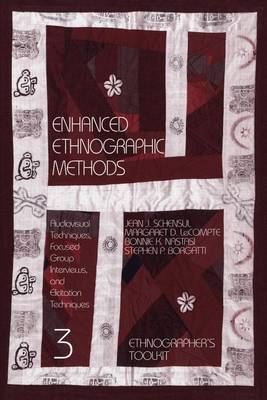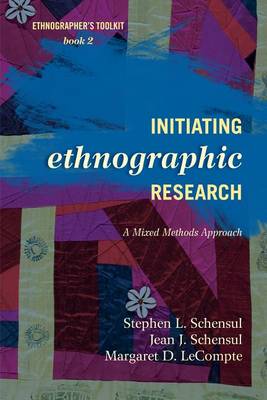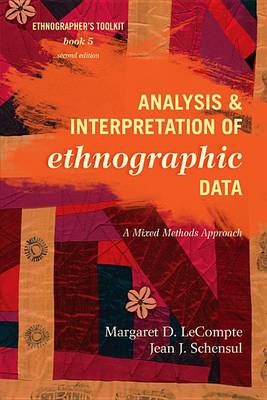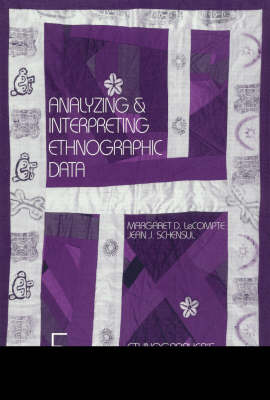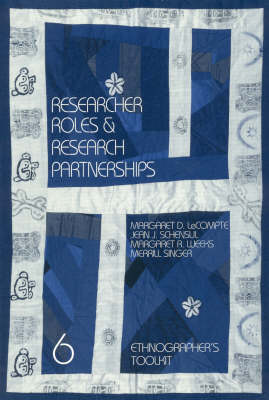Ethnographer's Toolkit
10 total works
v. 4
Mapping Social Networks, Spatial Data, and Hidden Populations
by Jean J Schensul
Enhanced Ethnographic Methods
by Stephen P. Borgatti, Jean J Schensul, Margaret D LeCompte, and Bonnie K Nastasi
Initiating Ethnographic Research
by Stephen L Schensul, Jean J Schensul, and Margaret D LeCompte
Initiating Ethnographic Research: A Mixed Methods Approach, is the first book of its kind. Unlike texts that describe and detail methods for doing ethnographic and qualitative research once in the field, Book 2 explores in depth the many critical issues that ethnographic researchers need to consider before going to the field and in the earliest stages of the field experience. These include preparation of self, establishing relationships that ensure access to the field, and steps in the construction of a formative theoretical model that will inform the entire research process from start to finish. Following guidelines established in Book 1, the first three chapters describe the reasons why ethnography should be considered a mixed methods approach to social science research. They discuss why theory is important in guiding a study, and the important institutional and personal preparations required to enter a field setting and begin work. Additional chapters debunk the idea that ethnographers always enter the field with their minds a "clean slate" in terms of what they will find during their investigation. They show why and how researchers can develop initial theoretical models based on local knowledge and literature reviews. Ethnography uses a holistic approach, so such models take into consideration both individual/population and systemic or structural considerations. They lead the way to integrating ecological, empirical, critical, and interpretivist approaches into a comprehensive analysis of a dynamic system. Two chapters also provide detailed examples to illustrate the connection between steps in the modeling process, creation of observational measures, and steps in data collection--from most open-ended kinds of interviewing and observation to the kind of highly structured ethnographic surveying described in Book 3. Extensive illustrative case examples are included. The final chapter shows how the modeling process can be extended to guide the development of interventions and change strategies at multiple levels-a process that should be part of any research program. A wide variety of diagrams, instructions, examples, and illustrations make the topics and processes covered in Book 2 easy to read and understand, even by novice researchers. Overall, Book 2 offers a unique mixed methods lens through which to build theory by engaging in research modeling, to enter the field, to set up to gather data, and to anticipate influencing change.
Other books in the set:
Book 1:
Designing and Conducting Ethnographic Research: An Introduction, Second Edition
by Margaret D. LeCompte and Jean J. Schensul
9780759118690
Book 3:
Essential Ethnographic Methods: A Mixed Methods Approach, Second Edition
by Jean J. Schensul and Margaret D. LeCompte
9780759122031
Book 4:
Specialized Ethnographic Methods: A Mixed Methods Approach
edited by Jean J. Schensul and Margaret D. LeCompte
9780759122055
Book 5:
Analysis and Interpretation of Ethnographic Data: A Mixed Methods Approach, Second Edition
by Margaret D. LeCompte and Jean J. Schensul
9780759122079
Book 6:
Ethics in Ethnography: A Mixed Methods Approach
by Margaret D. LeCompte and Jean J. Schensul
9780759122093
Book 7:
Ethnography in Action: A Mixed Methods Approach
by Jean J. Schensul and Margaret D. LeCompte
9780759122116
The chapters cover open-ended and focused listening, questioning strategies, participant and non-participant observation, recording techniques, visual recall, strategies for mapping the environments and contexts in which participant behavior occurs, and varied approaches to individual- and group-level in-depth interviewing. Unlike most methods texts, Book 3 also examines how and why to carry out ethnographically informed qualitative and quantitative survey research. It also provides the basis for quantification of qualitative research for those who wish to do so. Research methods are sequenced in accordance with early, middle, and later stages of a research project, making it easy for readers to select different data collection methods for specific purposes and timelines. This mixed methods approach is emphasized because it is the only way that are ethnographers able to obtain the holistic portrayal of dynamic social systems and cultural phenomena that characterize the best ethnographies.
Analysis and Interpretation of Ethnographic Data
by Margaret D LeCompte and Jean J Schensul
Treating analysis as both a mechanical and a cognitive process, Book 5 begins by describing why analysis and interpretation of data are necessary. In the first two chapters the book points out the importance of beginning ethnographic analysis in the field, during the earliest stages of data collection, and how to move between induction and deduction, the concrete and the abstract, in a process informed by an emerging and increasingly refined conceptual model. The middle section tackles the challenge of transforming huge piles of text, audio, and visual information into
an ethnographic whole through generic and specific coding and quantification of qualitative data, using multiple extended examples. Chapters show how to use computers in analysis of qualitative data and ways to integrate the results of quantitative and qualitative data into a comprehensive picture of a complex whole. Chapter 9 presents a rare and comprehensive description of the statistics
regularly used by ethnographers to analyze ethnographic surveys. Chapters 10 and 11 show how researchers create and then fine-tune preliminary results into an integrated whole, display them for multiple audiences, and write them up. The final chapter illustrates how ethnographers can share the meaning of results with local communities and constituents and with other professional researchers.
Other books in the set:
Book 1:
Designing and Conducting Ethnographic Research: An Introduction, Second Edition
by Margaret D. LeCompte and Jean J. Schensul
9780759118690
Book 2:
Initiating Ethnographic Research: A Mixed Methods Approach
by Stephen L. Schensul, Jean J. Schensul, and Margaret D. LeCompte
9780759122017
Book 3:
Essential Ethnographic Methods: A Mixed Methods Approach, Second Edition
by Jean J. Schensul and Margaret D. LeCompte
9780759122031
Book 4:
Specialized Ethnographic Methods: A Mixed Methods Approach
edited by Jean J. Schensul and Margaret D. LeCompte
9780759122055
Book 6:
Ethics in Ethnography: A Mixed Methods Approach
by Margaret D. LeCompte and Jean J. Schensul
9780759122093
Book 7:
Ethnography in Action: A Mixed Methods Approach
by Jean J. Schensul and Margaret D. LeCompte
9780759122116
v. 1
Designing and Conducting Ethnographic Research
by Margaret D LeCompte and Jean J Schensul
The Ethnographer's Toolkit series begins with this primer, which introduces novice and expert practitioners alike to the process of ethnographic research, including answers to questions such as who should and can do ethnography, when it is used most fruitfully, and how research projects are carried out from conceptualization to the uses of research results. Written in practical, straightforward language, this new edition defines the qualitative research enterprise, links research strategies to theoretical paradigms, and outlines the ways in which an ethnographic study can be designed. Use Designing and Conducting Ethnographic Research as a guide to the entire Toolkit or as a stand-alone introduction to ethnographic research.
Other books in the set:
Book 2:
Initiating Ethnographic Research: A Mixed Methods Approach
by Stephen L. Schensul, Jean J. Schensul, and Margaret D. LeCompte
9780759122017
Book 3:
Essential Ethnographic Methods: A Mixed Methods Approach, Second Edition
by Jean J. Schensul and Margaret D. LeCompte
9780759122031
Book 4:
Specialized Ethnographic Methods: A Mixed Methods Approach
edited by Jean J. Schensul and Margaret D. LeCompte
9780759122055
Book 5:
Analysis and Interpretation of Ethnographic Data: A Mixed Methods Approach, Second Edition
by Margaret D. LeCompte and Jean J. Schensul
9780759122079
Book 6:
Ethics in Ethnography: A Mixed Methods Approach
by Margaret D. LeCompte and Jean J. Schensul
9780759122093
Book 7:
Ethnography in Action: A Mixed Methods Approach
by Jean J. Schensul and Margaret D. LeCompte
9780759122116
v. 7
Using Ethnographic Data
by Jean J Schensul, Margaret Diane LeCompte, Alfred G. Hess, B.K. Nastasi, Marlene J. Berg, Lynne Williamson, Jeremy Brecher, and Ruth Glasser
v. 5
Analyzing and Interpreting Ethnographic Data
by Margaret Diane LeCompte and Jean J Schensul
v. 6

